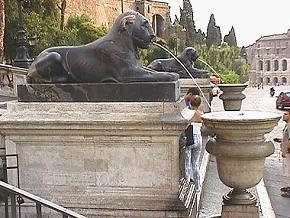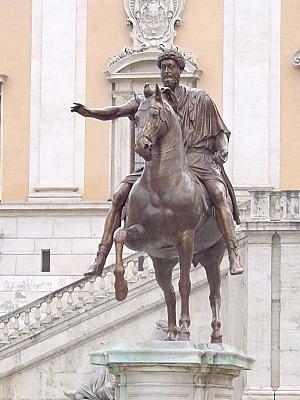|
|
 |
|
Campidoglio |
|
written
by sariah / 09.28.2005 |
|
|
| |
Description |
| |
| |

|
| www.storiaeconservazione.unirc.it/ |
| Aerial Sketch of the Campidoglio |
| This aerial diagram demonstrates the unique trapezoidal positioning of the three palazzos of the Campidoglio. Also apparent is the strong architectural axis that runs from the staircase (cordonata) to the Palazzo Senatorio. |
| |
|
| |

|
| f_pollett.tripod.com/ romaft38i.htm |
| Lions at the Base of the Cordonata |
| These two egyptian lion fountains guard the base of the cordonata. It is rumored that when a new pope moves into the Laterno Palace, these lions spout wine instead of water. |
| |
|
| |

|
| http://www.abcroma.com /Monumenti/Images/ Campidoglio-D3.jpg |
| One of the Dioscuri |
| This is a photograph of Castor, who with his equally massive brother Pollux, sit at the top of the Campidoglio's cordonata. |
| |
|
| |

|
| http://www.forum-rom.de/ 3%20roemischer%20spaziergang/ P7250368%202.jpg |
| Fountain at the Base of Palazzo Senatorio |
| Two statues of river gods and a blended representation of the goddesses Minerva/Roma combine to form a fountain at the base of Palazzo Senatorio. |
| |
|
| |

|
| http://it.wikipedia.org/ wiki/Immagine: Marco_Aurelio_Campidoglio_front_2.jpg |
| Equestrian Statue of Marcus Aurelius |
| This statue of marcus Aurelius is a focal point of the Campidoglio. The statue in the square today is a replica, and the original, the oldest surviving equestrian statue, is displayed in the Capitoline Museums. Legend has it that if the gold gilding on the bronze statue of Marcus Aurelius completely reappears, it will signal the end of Rome and the end of the world. |
| |
|
The Campidoglio is widely considered an superior example of urban design. To reach the square, one must first ascend the gently sloping, ramped staircase lined by unique pieces of sculpture. At the base of the staircase, or cordonata, lie two black Egyptian lions from 2nd century ACE. Originally installed as sculptures, they were later transformed into fountains with urns collecting streaming water by the architect Giacomo della Porta.
As one continues to ascend the staircase, two giant statues of the Dioscuri stand on the ballistrade. Hatched from an egg, these devoted brothers were the mythical twin sons of Zeus and Leda; since according to legend, Zeus had impregnated Leda in the guise of a swan. These two statues have two oddly shaped caps, representing the remnants of eggshell from which the twins were hatched. Since they are believed to be the special protectors of Rome, their special placement on the ballistrade is well warranted.
Beside the Dioscuri are two coats of arms representing the spoils of war that were returned to Rome from military victories. Because of the Capitoline Hill’s special significance as the final site for triumphal marches, these serve as reminders of ancient Rome’s military power. Finally, also on the ballistrade farthest from the stairs, are two statues representing Constantine and his son, Constantine II. Recognition of Emperor Constantine as the first Christian emperor accounts for the prominent placement of these statues on the ballistrade.
As one reaches the top of the cordonata, the square emerges slowly and magnificently. The three buildings facing the viewer create a sense of enclosure. Directly in front of the viewer lies the Palazzo Senatorio, with its enormous triangular staircase leading up towards the entrance. Framed within the staircase foundation is an ornamental fountain. Like the Egyptian lions at the base of the cordonata, this fountain is a deviation from Michelangelo’s original design. In a central curved niche stands a statue of a blended Minerva and Roma. She holds in her hand a globe symbolizing Rome’s hold on the world, a theme that is often repeated throughout the square. On either side, she is flanked by two river gods representing the Nile and Tiber Rivers, thus symbolizing the geographical expansiveness of the Roman Empire.
On the right and left sides of the square lie the Palazzo dei Conservatori and Palazzo Nuovo respectively. These two buildings currently house the Capitoline Museums. Although it is not obvious to the viewer, the two palaces form an unusual 80 degree angle with the Palazzo Senatorio. As a result, the square is really a trapezoid, with the equestrian Statue of Marcus Aurelius located at its center. When Pope Paul III had originally ordered the placement of this statue, he had mistakenly believed that it was a depiction of Constantine, the first Christian emperor. Although the current statue is a replica, the original may be found in the Capitoline Museums.
This equestrian statue is highlighted by its oval pedestal and the unique star- shaped design of the surrounding pavement. The pedestal itself was Michelangelo’s first task for the square when Pope Paul III contacted him to redesign Capitoline Hill, and it still bears the Papal Seal of Paul III. However, Michelangelo’s original design of the stellate pattern was only recreated recently in 1940 by Mussolini, who ordered that the radiating pattern of Giacomo della Porta (the architect who carried out most of the building of the Campidoglio after Michelangelo’s death) be replaced.
Overall, the square is defined by a strong sense of traditional symmetry. Michelangelo firmly believed in Vetruvian dynamics through architecture, and designed the Palazzo Nuovo specifically to fulfill a symmetric, not functional, requirement. In an undated letter, Michelangelo wrote that “the central elements are always free”, but that “corresponding parts of a plan must be identical, just as one hand is obliged to be like the other in the human body”. This sentiment is clearly followed in the Campidoglio. Despite its unique trapezoidal character, each element of the square firmly adheres to symmetry along a strong central axis that leads to the Palazzo Senatorio.
However, not all of Michalengelo’s design was based in tradition. Importantly, his design of the Palazzo dei Conservatori and the corresponding Palazzo Nuovo incorporate the first examples of a “giant column”, defined as a column that extends higher than one story. These façade elements, along with smaller, one story ionic columns, disguise the actual structural building support and imbibe a commanding presence to these buildings.
|
| |
|
| |
|
|
 |
|





